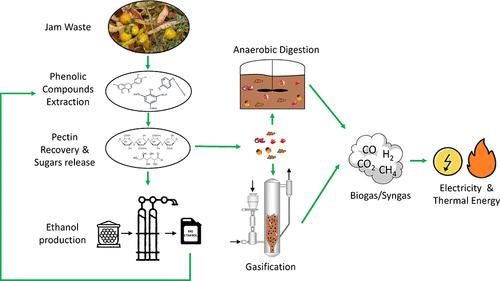围绕果酱生产废弃物发展循环经济
IF 3.9
3区 工程技术
Q2 ENGINEERING, CHEMICAL
引用次数: 0
摘要
根据文献中描述的装置运行实验数据,系统地开发了一个综合工艺的概念和放大设计,以围绕果酱废料创造循环经济。该工艺包括酚类化合物提取、果胶回收、生产绿色溶剂乙醇(供内部使用和最终产品),而几个阶段产生的固体残留物可通过气化或消化产生热能和电力。基础案例是一个真正的果酱生产设施。废料处理需要约 200 万欧元/年,处理 37 吨/年的废料,生产 5.2 公斤/吨的酚类化合物和 15.9 公斤/吨的果胶。这两种技术都有利可图。不过,厌氧消化不仅成本更低,而且进入门槛也更低,仅为 2.7 百万欧元(厌氧消化)和 3.4 百万欧元(GA)。此外,还进行了规模扩大研究,结果表明厌氧消化比固体气化更能从规模经济中获益。这两种工艺在电力方面都能自给自足,但需要额外输入热能。此外,两种工艺都符合循环原则,总体循环指数超过 0.52。本文章由计算机程序翻译,如有差异,请以英文原文为准。

Developing a Circular Economy around Jam Production Wastes
A conceptual and scaled-up design of an integrated process is systematically developed to create a circular economy around jam waste based on experimental data from the operation of the units described in the literature. It consists of phenolic compounds extraction, pectin recovery, and the production of a green solvent, ethanol, for internal use and the final product, while the solid residues from several stages can be either gasified or digested to produce thermal energy and power. The base case is a real jam production facility. Waste processing requires around 2 M€/yr to process 37 t/yr of waste, producing 5.2 kg/t of phenolic compounds and 15.9 kg/t of pectin. Both technologies are profitable. However, anaerobic digestion is not only cheaper but also presents a lower entrance barrier, 2.7 (AD) versus 3.4 (GA) M€. A scale-up study is also performed, showing that anaerobic digestion benefits from economies of scale more than solids gasification. The processes are self-sufficient in terms of power but require additional input of thermal energy. In addition, both processes comply with the principles of circularity, achieving an overall circularity index above 0.52.
求助全文
通过发布文献求助,成功后即可免费获取论文全文。
去求助
来源期刊

Industrial & Engineering Chemistry Research
工程技术-工程:化工
CiteScore
7.40
自引率
7.10%
发文量
1467
审稿时长
2.8 months
期刊介绍:
ndustrial & Engineering Chemistry, with variations in title and format, has been published since 1909 by the American Chemical Society. Industrial & Engineering Chemistry Research is a weekly publication that reports industrial and academic research in the broad fields of applied chemistry and chemical engineering with special focus on fundamentals, processes, and products.
 求助内容:
求助内容: 应助结果提醒方式:
应助结果提醒方式:


